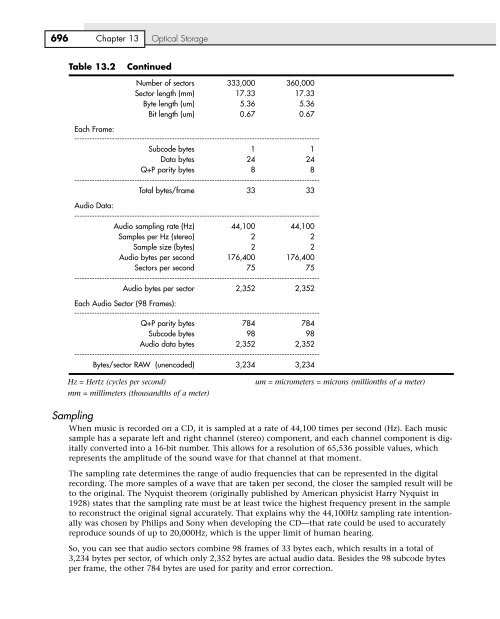Create successful ePaper yourself
Turn your PDF publications into a flip-book with our unique Google optimized e-Paper software.
696 Chapter <strong>13</strong> Optical Storage<br />
Table <strong>13</strong>.2 Continued<br />
Number of sectors 333,000 360,000<br />
Sector length (mm) 17.33 17.33<br />
Byte length (um) 5.36 5.36<br />
Bit length (um) 0.67 0.67<br />
Each Frame:<br />
--------------------------------------------------------------------------------------------------<br />
Subcode bytes 1 1<br />
Data bytes 24 24<br />
Q+P parity bytes 8 8<br />
--------------------------------------------------------------------------------------------------<br />
Total bytes/frame 33 33<br />
Audio Data:<br />
--------------------------------------------------------------------------------------------------<br />
Audio sampling rate (Hz) 44,100 44,100<br />
Samples per Hz (stereo) 2 2<br />
Sample size (bytes) 2 2<br />
Audio bytes per second 176,400 176,400<br />
Sectors per second 75 75<br />
--------------------------------------------------------------------------------------------------<br />
Audio bytes per sector 2,352 2,352<br />
Each Audio Sector (98 Frames):<br />
--------------------------------------------------------------------------------------------------<br />
Q+P parity bytes 784 784<br />
Subcode bytes 98 98<br />
Audio data bytes 2,352 2,352<br />
--------------------------------------------------------------------------------------------------<br />
Bytes/sector RAW (unencoded) 3,234 3,234<br />
Hz = Hertz (cycles per second) um = micrometers = microns (millionths of a meter)<br />
mm = millimeters (thousandths of a meter)<br />
Sampling<br />
When music is recorded on a CD, it is sampled at a rate of 44,100 times per second (Hz). Each music<br />
sample has a separate left and right channel (stereo) component, and each channel component is digitally<br />
converted into a 16-bit number. This allows for a resolution of 65,536 possible values, which<br />
represents the amplitude of the sound wave for that channel at that moment.<br />
The sampling rate determines the range of audio frequencies that can be represented in the digital<br />
recording. The more samples of a wave that are taken per second, the closer the sampled result will be<br />
to the original. The Nyquist theorem (originally published by American physicist Harry Nyquist in<br />
1928) states that the sampling rate must be at least twice the highest frequency present in the sample<br />
to reconstruct the original signal accurately. That explains why the 44,100Hz sampling rate intentionally<br />
was chosen by Philips and Sony when developing the CD—that rate could be used to accurately<br />
reproduce sounds of up to 20,000Hz, which is the upper limit of human hearing.<br />
So, you can see that audio sectors combine 98 frames of 33 bytes each, which results in a total of<br />
3,234 bytes per sector, of which only 2,352 bytes are actual audio data. Besides the 98 subcode bytes<br />
per frame, the other 784 bytes are used for parity and error correction.
















